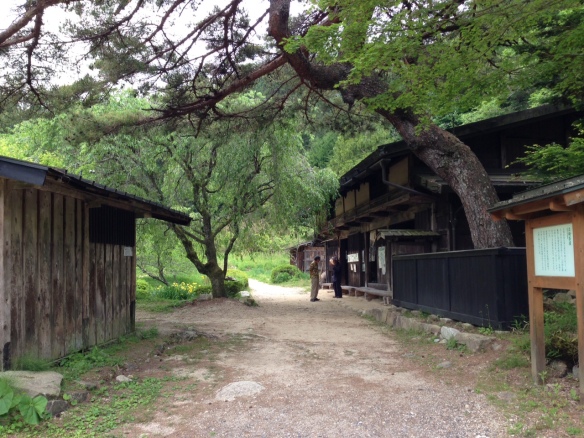Over the last year and a half working for Walk Japan, mostly waking an ancient trade and pilgrimage road called the Nakasendo, I have met some fascinating people. They break the stereotypes of what Japanese people are like – working long hours, group-oriented, quiet, respectful etc. I like people who break stereotypes though. They are the ones who don’t need or want to be molded by societal pressures. Life is too short. Quite frankly they are just more interesting. I am meeting more of them in Japan, and being someone who can never quite fit in myself, I like it. I think it’s good for the country. And for whatever reason, compared to the cities I see so many more cool people like them in the countryside, which is partly why I like living in Nagano. Here are a few of their stories.
There are several people on the Nakasendo that consistently find their way into the most memorable of the trip. First, there is the boar-hunting inn keeper Hara San, who grows his own rice and with his wife greets you with a smile and waves until you’ve walked out of sight around the last bend in the road. Their genuine thankfulness for you staying with them is something Western countries could learn from. When we are staying there, after I get everyone settled into their rooms he always gets a glimmer in his eye, asks if it was a long day and offers me some “wheat tea”, his euphemism for a cold Asahi. At dinner, without fail I am offered a glass of “water” (sake).
Then of course, there are the cooks/musicians/conductors extraordinaire – Mr. and Mrs. Ando. After arriving at their log cabin/restaurant, you sit down to a full view of Mt. Ontake, the second highest volcano in Japan after Mt. Fuji. They bring out miso pizza, margarita pizza and fresh-baked bread (this is the 8th day of the trip and almost everyone is happy to get away from rice). But lunch is just getting started. Mr. Ando plays – to the best of his ability – the Tsugaru Shamisen, a traditional 3-stringed instrument that is actually really cool when done correctly (check out this video). Then Mrs. Ando, who plays the harmonica beautifully, plays an old Japanese lullaby that often brings people to tears. At that point, it’s time for the unforgettable Kiso Valley folk song (see video) before the grand finale of it all, a demonstration of the model train set that Mr. Ando has built around the entire house. This couple breaks all the stereotypes and it’s awesome.

Mr. Ando on the far right
But my favorite person of all has to be Mr. Suzuki. He is a 75-year-old retiree who runs an ancient tea house along the Nakasendo. He volunteers to run the place, dressing in traditional garb and singing his own version of the Kiso folk song for our entertainment. He’s also recently added a wedding song to his repertoire. He serves the group tea afterwards, communicating amazingly well for someone who speaks about 20 words of English (I help him out by translating too). His two favorite topics of discussion that almost always seem to come up are 1) you will live long by drinking more sake and 2) Japanese men are too “vegetarian” these days (they don’t get married and make enough kids). Needless to say, he is a fascinating old guy with stories and legends to tell about the valley that he has called home his entire life. I aspire to having that kind of dedication to a place and vitality when I am that age.

Mr. Suzuki. Photo credit to Fernando Gros
People often wonder why I would want to live in Japan. Admittedly, it’s not as comfortable, communication is a little more difficult and it’s a long way from family. But it’s about the people. I am fascinated by their diversity and the rich culture/history that I get to live in. I feel like I learn something new every day. I never appreciated that as a kid. And on the surface, it might be harder to “get in” with people, especially ones who are in the rat race in the big cities. But there is a subculture of Japanese who are moving back for a better life and once you are in, you are in. Their loyalty and dedication to what they do is overwhelming. In the end, I think comfort is overrated anyway. At least in this point in my life, I prefer adventure.


